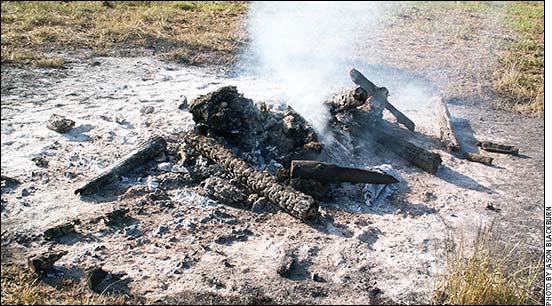
Anthrax organisms within an animal’s body or bodily secretions can be readily destroyed by high heat, so burning carcasses is a disposal option.
Ancient Anthrax
Ancient disease just keeps cropping up.
Anthrax is one of the oldest killers. It occurs sporadically in the United States and Canada, causing sudden death of cattle and sheep, though it can infect any warm-blooded animal.
This acutely contagious and deadly disease is usually not spread from live animal to live animal, except by flies that bite a sick animal and then bite a healthy one. It is typically transmitted via spores found in carcasses of animals that died of the disease.
Anthrax organisms within an animal’s body or bodily secretions can be readily destroyed by disinfectants or high heat. Once the animal dies and the carcass is opened and bacteria are exposed to the air, they form spores. These spores are resistant to heat, cold, freezing, chemical disinfectants or drying. They can survive in contaminated soil a long time. The carcass may be long gone, but spores are still viable in surrounding soil and can be spread to other areas by flooding.
Martin Hugh-Jones, professor emeritus in the Department of Environmental Sciences at Louisiana State University, says bison had anthrax in North America long before cattle were here.
“There are accounts of anthrax in records from the Hudson Bay Company, about 1820. In all the areas they were reporting anthrax, we are still seeing it today,” he says.
“We can do a pretty good job of controlling it if stockmen vaccinate every spring. If there are outbreaks, it’s usually because some people didn’t vaccinate. If we have an outbreak, we must deal with it quickly,” says Hugh-Jones.
If horseflies feed on a sick animal and then feed on healthy animals, they may transfer the infection to neighboring herds. Horseflies can travel more than 12 miles. Vaccination is not only to protect your animals, but also those of your neighbor, he explains.
If an animal is found suddenly dead, find out what killed it. If it’s not something obvious, like lightning or a broken neck, call the vet out to have a proper diagnosis.
“The veterinarian will dip a cotton swab in the animal’s blood, and send it to the lab, and should have an answer within 18 hours. There are some U.S. Navy field test kits that take only 15 minutes to give results, right there at the carcass. Those are ideal for a fast diagnosis,” he says.
“If an animal dies of anthrax, you want to catch the problem early so it won’t be spread to other animals, and take the necessary precautions. This means taking other animals out of that field, getting them vaccinated, and burning the carcasses of any that died. Never leave a carcass lying there, or the ground around it becomes contaminated — which could cause trouble for years to come,” he says.
Carcasses should be burned, if possible, or buried at least 7 feet deep, he says. “Don’t handle the carcass; this is a good way to become infected yourself.”
If people don’t vaccinate live cattle, and don’t get rid of carcasses, the disease will persist indefinitely. In many countries, however, they’ve had successful vaccination programs and the disease has disappeared. It’s no longer seen in Poland or Germany, and the UK is essentially free of it. Scandinavian countries see only a few cases now and then. In most of western Europe, the disease has all but disappeared, says Hugh-Jones.
“We see it in areas where soil conditions are perfect for spores to survive, and this includes black prairie soil. We need to make sure we don’t have future outbreaks to recontaminate the soil with spores. We see cases occurring when people are bulldozing or putting in a water line, and dig through old cattle or bison graves,” he explains.
“In theory, anthrax may have disappeared from an area if you don’t have any cases for five years, but you still need to be aware and alert for it during the summer. If you have a neighbor who doesn’t pay attention to his animals and a number of them get sick, your animals will get it if biting flies come to your place to feed on your animals, so it is important to vaccinate. I’ve seen this many times, when anthrax spreads from sick cattle via flies,” he says.
The vaccine gives immunity for about nine months. It’s best to vaccinate for anthrax ahead of the main risks. It often occurs in mid- to late summer when weather is very hot, so check cattle frequently and make sure you are not losing some. If you lose one and respond quickly to get a diagnosis, you could possibly halt an outbreak that would otherwise be devastating.

Editor’s Note: Heather Smith Thomas is a cattlewoman and freelance writer from Salmon, Idaho.






